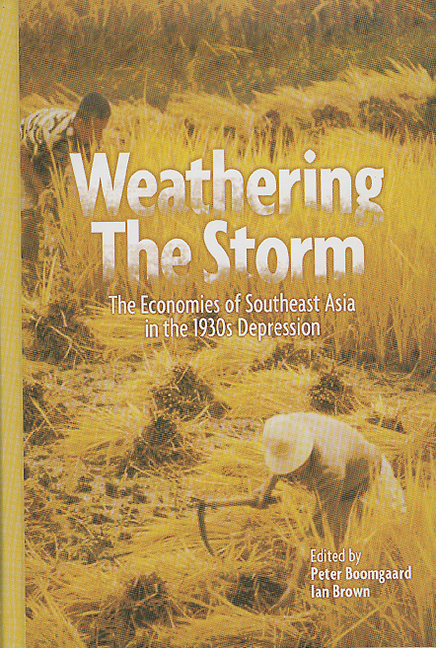Book contents
- Frontmatter
- Contents
- List of Tables
- List of Figures
- Acknowledgements
- List of Contributors
- 1 The Economies of Southeast Asia in the 1930s Depression: An Introduction
- PART I MATERIAL CONDITIONS
- PART II AGRICULTURAL STRATEGIES
- 6 Structural Origins of the Economic Depression in Indonesia During the 1930s
- 7 Entrepreneurial Strategies in Indigenous Export Agriculture in the Outer Islands of Colonial Indonesia, 1925-38
- 8 The Economy of Besuki in the 1930s Depression
- 9 The Rice Economy of Thailand in the 1930s Depression
- 10 Rice and the Colonial Lobby: The Economic Crisis in French Indo-China in the 1920s and 1930s
- PART III TRADING COMMUNITIES
- PART IV THE STATE'S RESPONSE
- Index
6 - Structural Origins of the Economic Depression in Indonesia During the 1930s
from PART II - AGRICULTURAL STRATEGIES
Published online by Cambridge University Press: 21 October 2015
- Frontmatter
- Contents
- List of Tables
- List of Figures
- Acknowledgements
- List of Contributors
- 1 The Economies of Southeast Asia in the 1930s Depression: An Introduction
- PART I MATERIAL CONDITIONS
- PART II AGRICULTURAL STRATEGIES
- 6 Structural Origins of the Economic Depression in Indonesia During the 1930s
- 7 Entrepreneurial Strategies in Indigenous Export Agriculture in the Outer Islands of Colonial Indonesia, 1925-38
- 8 The Economy of Besuki in the 1930s Depression
- 9 The Rice Economy of Thailand in the 1930s Depression
- 10 Rice and the Colonial Lobby: The Economic Crisis in French Indo-China in the 1920s and 1930s
- PART III TRADING COMMUNITIES
- PART IV THE STATE'S RESPONSE
- Index
Summary
When did things really change in Indonesia in modern times? Where do we situate the decisive break with the past in the formative processes of change which culminated in the nation-state and national economy of Indonesia today? In the sphere of politics the answer is easily given: 17 August 1945 with the declaration of Indonesian independence, even if the Japanese invasion in the spring of 1942 had effectively brought Dutch colonial rule over the archipelago to an end — although Indonesian independence was formally acknowledged by the Dutch Government only in December 1949. The answer is less clear-cut when we turn to economic development. Dutch domination of Indonesian export production only came to an end with the nationalization of most Dutch-owned business enterprises in late 1957 and early 1958. This is surely the latest possible date for the decisive turnabout. At the other extreme, the hardship experienced by Indonesian export industries during the worldwide economic depression of the 1930s can be seen as a stark reversal of trends, with economic expansion being replaced by a stagnation that was to continue through to the 1950s and early 1960s. This chapter argues that the turning point in the development of the modern Indonesian economy may indeed be found in the depression of the 1930s — thus preceding the fundamental reorientation in political development by at least a decade.
A turning point in economic life implies a shift to a different phase of development in the long run. This indeed occurred in Indonesia, where two periods of rapid economic expansion — the quarter of a century leading up to 1930, and another quarter of a century from the inauguration of the New Order in the late 1960s through to the late 1990s — are separated by an intervening period of stagnating or even declining incomes and standards of living. Another implication is that earlier conditions are not simply restored after a while but give way to a different type of development.
- Type
- Chapter
- Information
- Weathering the StormThe Economies of Southeast Asia in the 1930s Depression, pp. 123 - 142Publisher: ISEAS–Yusof Ishak InstitutePrint publication year: 2001



